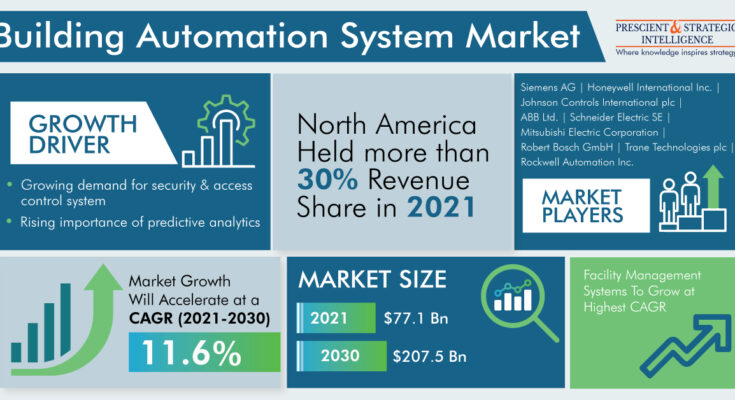The total size of the building automation system market size was above $77 billion in the year 2021, and it will reach about $208 billion by 2030, advancing with a growth rate of about 12% in the years to come. The upward demand for energy-efficient buildings, lesser costs of operations and maintenance, improved indoor air quality, and accomplished home automation services and progressions in communications, analytics, sensors, and touch-screen technology propel the market growth.
Commercial buildings in 2021, had the largest share of revenue of about 40% building automation system market. As per a government organization, approximately 30% of the energy utilized in commercial structures is wasted and can be saved using BAS, as these can control heating and cooling, appliances, lighting, and other energy requirements, to exploit energy efficiency and worker efficiency. Hence, commercial structures like malls, warehouses, supermarkets, restaurants, offices, colleges, schools, museums, libraries, hospitals, and nursing homes, are accepting these solutions to curtail costs related to building management.
The wireless systems will advance at a higher growth rate, of approximately 14%, in the years to come, as these systems are easy to mount and use and offer greater flexibility and control compared to their wired counterparts. Additionally, key companies are developing wireless sensors, devices, and controllers to operate the systems remotely.
The wired systems dominated the building automation system market in 2021. Since wired systems are devoted to definite tasks, their performance is usually better than wireless ones. Additionally, system latency is significantly reduced, therefore permitting seamless operation of numerous circuits, chiefly while execution of intricate processes including several circuits or devices.
North America has the largest share in the market with a share of in excess of 30%, in the year 2021. This is chiefly credited to technological progressions, strict energy efficiency regulations, and quick acceptance of building automation. Furthermore, the rising spending on facility management in administration buildings is contributing to the acceptance of these solutions.
APAC will grow the fastest in the building automation system market in the coming years. The increasing apprehensions about security and the rising need for integrated security systems are the main drivers for the market in the region. As the count of smart building solution providers has augmented considerably and smart building technologies have become inexpensive, the costs of operations for the appropriate operation have declined in the recent past.
The rising demand for these facilities in the tourism, hospitality, and construction sectors are the market drivers. Also, the government initiatives and support for the developing smart cities and business hubs would call for high requirements for the services of facility management, therefore pushing the demand for automation solutions.
Economic expansion, pushed by urbanization, is an important factor for the growth of the building automation system market, as infra development in metro cities would make facility management services significant. Furthermore, the growth of SEZs and mega food parks will aid the development of the industry in the coming years.
There is a constant increase in the demand for building automation systems, because of the increasing requirement for security and access control systems.




